6
Adding Artwork and Tags to Your SoundCloud Audio
THE STORING, SOURCING, COLLATING, AND REFERENCING of information online is a system so complex that many of us don’t even compute the extent of this mammoth task. That is, until it affects us. And with SoundCloud, a very specific aspect of this does—the referencing of information.
Use Your Words (and Pictures)
Without information—be it your description, image, or tags—your track may as well have stayed on your machine in an unnamed file. Well, maybe that’s a bit dramatic, but adding the right information to your track could make a world of difference—the difference between someone actively finding you and someone stumbling onto your track by chance alone. All those bits of information act as clues to SoundClound users, and placing them correctly will help existing and prospective fans discover your music.
Using Tags
Tags are keywords assigned to your track, and their purpose is to direct music lovers searching for a particular genre or style in your direction (see Figure 6.1). With tags, it is best to use accepted or popular genres—for example, “dubstep,” “folk,” or “alternative.” Other keywords you may want to consider include instruments—did you use a theremin, guitar, or xylophone?
Figure 6.1 Adding tags to your SoundCloud tracks.
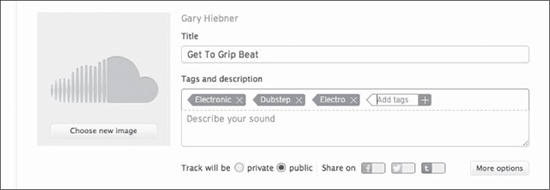
Source: SoundCloud®.
Search for some keywords in SoundCloud and look at the results. Click on a particular track to load it and see what other tags were attached to it. Being descriptive is important, but don’t go overboard with your tags—stick to the most relevant keywords. A good tip is to imagine you’re the ideal fan. Think about what you’d type into the SoundCloud search bar to find your song.
Creating a Description
In the Description box, you can provide a more detailed description of your track. Maybe you’ve been working on a new track for the last few months, and finally you can upload a version of it so that your fans can listen to it. In the description, you can let your listeners know it’s a new track.
In the Description box, you want to give that little bit of extra information to draw in your listener. The description should entice them to play the track. So try to make your description a bit more conversational, but also informative (see Figure 6.2).
Figure 6.2 Adding a description to your SoundCloud track.
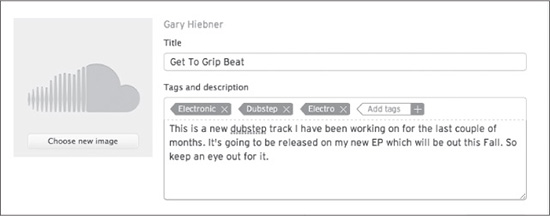
Source: SoundCloud®.
You could even add links in here to where your track is being sold. Maybe your track is up on sites such as iTunes, Nimbit, or ReverbNation. List the links here so that your fans know where to go if they want to purchase the track.
We’d suggest, though, that you add the most important information about the track in the first two to three lines, as SoundCloud will not display the whole description if it is quite lengthy. So, for example, if the links are quite important to you, add those quite early on.
Inserting Pictures and Images
Having a visually interesting image for each track can really help boost your chances of being noticed on SoundCloud. You know the old saying that you shouldn’t judge a book by its cover? Well, people may just click on your track because they’re responding to the image, or they may skip right by if it hasn’t caught their eye.
SoundCloud recommends an image size of 300 × 300 pixels in either JPG or PNG format. And keep the images down to a file size of about 2MB or smaller for the songs you upload. For your profile image, the size should be 200 × 200 pixels.
If you don’t have imaging-editing software on your computer, you can try GIMP (www.gimp.org), which is an open-source application.
What Not to Do with Your Images
A decent-quality image designed in the appropriate application or photographed with a camera or smartphone will look a lot better than an image snapped in low light, with poor composition, for example. If you don’t have the equipment you need, ask a friend or call in a favor rather than uploading a sub-par image. Remember, this image is an extension of you as an artist, and of your work. This is your digital CD cover—make sure it represents who you are and what your music stands for.
Adding Your Profile and Track Images
Let’s take a look at those all-important profile and track images. They may seem like just another step in the process, and maybe you find it unnecessary, but once you spend time on SoundCloud, you’ll see how often you notice a favorite musician based on the image first, before you’ve even read the name.
Adding Profile Images
There are two ways to add a profile image. You can click on the silhouetted person icon on the top toolbar of your page—it’s to the right, next to the envelope icon that represents your latest messages. When the menu drops down, click on Profile, as shown in Figure 6.3.
Figure 6.3 Navigating to your profile.
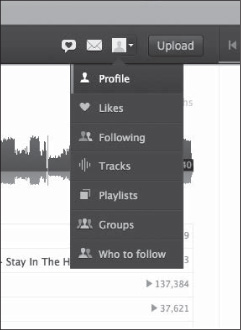
Source: SoundCloud®.
When you hover over the icon to the left (it’s a larger version of the one you were looking at in your taskbar), you’ll be prompted to choose a new image, as shown in Figure 6.4. Click on this to proceed.
Figure 6.4 Adding a profile image.
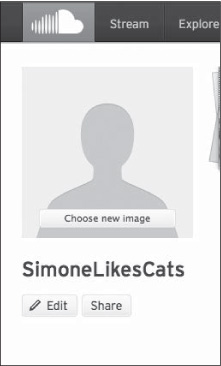
Source: SoundCloud®.
Below the larger image, you’ll see two options. Click on Upload New Image. (We’ll cover the Instagram option later.)
Navigate to the place on your machine where you’ve saved your image and click Open.
Once you’ve selected your image and successfully changed the profile picture, click on the black X at the top right of the screen to close the window, and you’ll be back on your profile page.
Hello, Instagram! Thanks to new innovations on both SoundCloud and Instagram, you can now upload your Instagram images straight to your tracks and playlist.
Instagram is a photo- and video-sharing application that allows users to snap images or film short movies and share them with the Instagram community, as well as on other social media applications. What started out as a quick way to snap a moment, add filters, and share has grown into an impressive community of smartphone-savvy photographers, videographers, and microbloggers capturing everything from their favorite meal to a bungee jump. The SoundCloud/Instagram integration means that you can take your own moment and use it as your profile or track artwork, complete with the “look” that has made Instagram so popular.
Try it out—in this example, we’re changing our profile icon:
1. Go to the silhouetted-person icon.
2. On the drop-down menu, click on Profile.
3. Once your profile page loads, click on Choose a New Image.
4. At the bottom left of the window, click on Instagram, as shown in Figure 6.5.
Figure 6.5 Using Instagram to set your profile image.
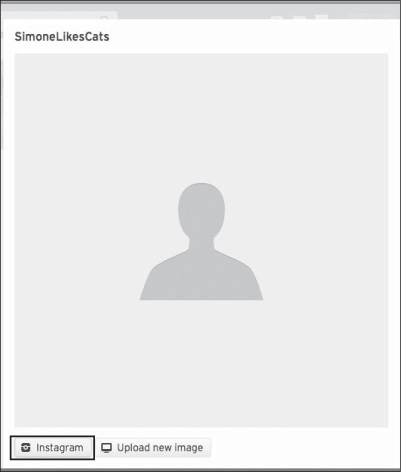
Source: SoundCloud®.
5. The button now changes to say Connecting. A pop-up window explains that Instagram wishes to connect with you. Click Authorize if you’re happy with the conditions.
6. Your Instagram feed will appear where the large silhouetted icon was. Scroll down, find the image you’d like to use, and click on it.
Once you have done this, you’ll see that your selected image is now your profile picture.
Adding Track Images
You could use your profile picture for your tracks as well, but even better, you can use a different image for each track you upload to SoundCloud. Maybe some of the songs you upload are from a particular album of yours. You could add this album image to the tracks. This also keeps it interesting for listeners. They’ll see different images when they navigate to your different tracks.
To add a different image for a track, first select the track you want to change from the Tracks submenu, shown in Figure 6.6.
Figure 6.6 Click on Tracks to add individual track images.

Source: SoundCloud®.
When the Track page opens, by default it’ll have your profile picture. Hover over this image until the Choose New Image option appears. Click on this and go through the same steps as you did to add a profile image. Now you’ll have a unique image for that track!
